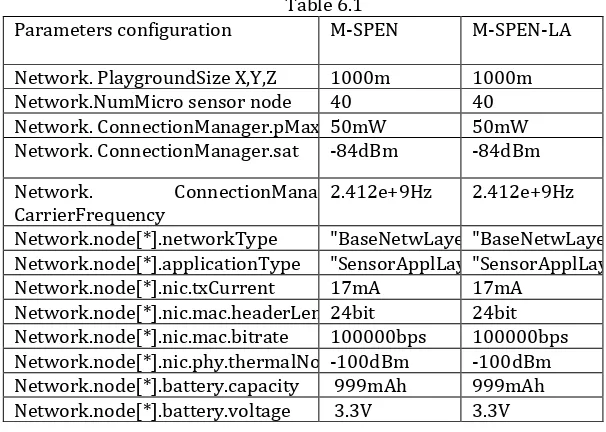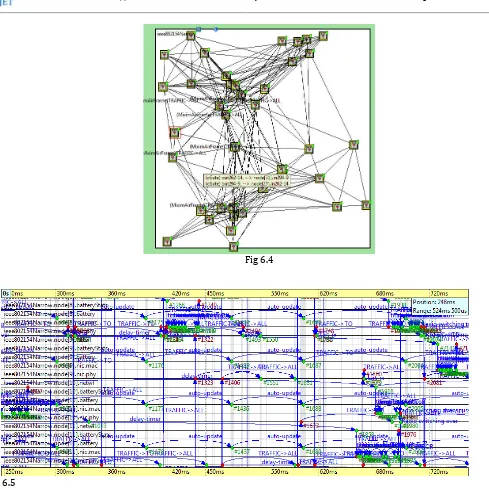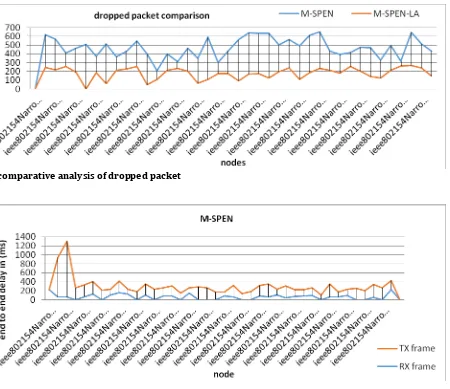© 2015, IRJET ISO 9001:2008 Certified Journal
Page 620
M-SPIN- LA Algorithm for energy efficient Wireless Sensor Networks on
2D Surface
Ashutosh Kumar Tiwari 1, Suresh Gawande2,
1PG scholar, Digital Communication, B.E.R.I Bhopal, M.P, India 2 Prophesier, Digital Communication, B.E.R.I Bhopal, M.P, India
Simulation of M-SPEN protocol
Simulation of Location aware protocol
Simulation ofM- SPEN- location aware
The comparison between M-SPEN and M-SPEN- location aware is performed over the common factors like throughput of dropped packets, end-to-end delay and energy consumption in the network over different simulation rounds. Also for short-range communication, SPEN with Location aware has been implemented over different topologies.
---***---
Abstract :Wireless Sensor Networks (WSNs) consist of thousands of tiny nodes having the capability of sensing, computation, and wireless communications. Many routing, power management, and data dissemination protocols have been specifically designed for WSNs where energy consumption is an essential design issues. Since wireless sensor network protocols are application specific, so the focus has been given to the routing protocols that might differ depending on the application and network architecture. The study of various routing protocols for sensor networks presents a classification for the various approaches pursued. The two main categories explored are negation based and location-based. Each of the routing schemes and algorithms has the common objective of trying to get better A comparison has been made between two routing protocols, M-SPEN & M-SPEN-LA, on the basis of throughput and power consumption of the network. Our simulation results show that the proposed algorithms can tolerate distance measurement errors, and thus work well under practical sensor network settings and effectively promote the performance a range of applications that depend on triangulations and energy efficiency approach .
Introduction
In this situation, the emergence of wireless sensor networks (WSNs) is essentially toward the miniaturization and ubiquity of computing instruments. Sensor networks are composed of countless numbers of valuable useful resource restricted sensor nodes and also some resourced base stations are there. All nodes in a community keep in touch with each and every one of a kind via wireless conversation. In addition, the vigor required to transmit a message is about twice as great as the vigor desired to obtain the equal message. The route of every message destined to the base station is quite central in phrases group lifetime: e.G., utilising rapid routes to the base station that comprises nodes with depleted batteries could yield decreased network lifetime. On the opposite hand, utilising a chronic route composed of many sensor nodes can greatly broaden the network extend.However, some standards for the routing protocols are conflicting. Consistently choosing the shortest route toward the backside station explanations the intermediate nodes to dissipate faster, this outcome in a diminished network lifetime. At the same time, regularly determining the shortest direction would results in lowest power consumption and lowest network extend. Sooner or later, the routing objectives are tailored by the use of the utility; e.G., real-time purposes require minimal community extend, while features performing statistical computations may just require maximized community lifetime. As a consequence, specified routing mechanisms had been proposed for distinctive purposes. These routing mechanisms notably variety in phrases of routing ambitions and routing systems, the place the approaches are more often than not influenced via the neighborhood characteristics.
RESULTS, PERFORMANCE EVALUATION & ANALYSIS
© 2015, IRJET ISO 9001:2008 Certified Journal
Page 621
6.1. Simulation of M-SPENSimulation of M-SPEN protocol is performed over 40 micro sensor node having same energy. Micro sensor node in the network are in random position. In this scenario there is a source node that will broadcast the data and all the neighbouring micro sensor node will do the same after receiving it. node 1 is the sink node. In figure 6.1 source micro sensor node is negotiate the data to its neighbouring micro sensor node. The negotiate of packets is shown by direction Because all the micro sensor node are negotiate the data, so there will be energy loss in the network continuously. When a particular node receives a fix amount of data it changes its color to show the energy loss. In figure 6.1 some micro sensor node became yellow due to receiving more broadcast and so more energy loss
Fig.6.1 M-SPEN micro sensor node
Fig.6.2
© 2015, IRJET ISO 9001:2008 Certified Journal
Page 622
Table 6.1Parameters configuration M-SPEN M-SPEN-LA
Network. PlaygroundSize X,Y,Z 1000m 1000m
Network.NumMicro sensor node 40 40
Network. ConnectionManager.pMax 50mW 50mW Network. ConnectionManager.sat -84dBm -84dBm
Network. ConnectionManager. CarrierFrequency
2.412e+9Hz 2.412e+9Hz
Network.node[*].networkType "BaseNetwLayer" "BaseNetwLayer" Network.node[*].applicationType "SensorApplLayer""SensorApplLayer" Network.node[*].nic.txCurrent 17mA 17mA
Network.node[*].nic.mac.headerLength24bit 24bit Network.node[*].nic.mac.bitrate 100000bps 100000bps Network.node[*].nic.phy.thermalNoise -100dBm -100dBm Network.node[*].battery.capacity 999mAh 999mAh Network.node[*].battery.voltage 3.3V 3.3V
Simulation of M-SPEN with location awareness Protocol
The same topology has been implemented for M-SPEN with location awareness protocol with same source node and same sink node. The difference between the simulation of SPEN and SPEN with location awareness protocol is that in M-SPEN-LA, the communication starts from node itself. When the node sends the interest about what its location, source node sends a coordinate in reply and then data is being delivered to the sink according with minimal transition power.
[image:3.595.146.449.88.304.2]In this simulation scenario, of all source micro sensor node node and other node 7 is the sink node. source node sends the location information to neighbor Source node . In figure 6.9, source node is sending location information to all the neighboring micro sensor node. All the micro sensor node in the network have a cache to store the different location. In figure 6.10, source node 7 is sending information back to the sink node through the same way.
Fig 6.3
© 2015, IRJET ISO 9001:2008 Certified Journal
Page 623
Fig 6.4Fig 6.5
The tracegraph snapshots have been taken with the simulation time of 941ms . In figure 6.5, the entire simulation scenario has been displayed along with the end-to-end delay. The throughput of sending and receiving protocols has been displayed in figure
[image:4.595.34.517.584.744.2]© 2015, IRJET ISO 9001:2008 Certified Journal
Page 624
On a average wee can estimate that M-SPEN-LA is 20% more efficient than M-SPENFig 6.7 comparative analysis of dropped packet
Routing is a significant issue in Wireless Sensor Networks. The objectives listed in the problem statement have been carried out properly. In the presented work, we have discussed a comparison of two routing protocols for wireless sensor network with different simulation rounds. Also location awareness topology over WSN is simulated with different topology changes. We sincerely hope that our work will contribute in providing further research directions in the area of routing. With the results of tracegraph, we can conclude that in the case of M-SPEN-LA, throughput of energy packets is quite less than the throughput in the case of M-SPEN. Also end-to-end delay is also better in the case of M-SPEN. Since energy of the nodes is a constraint in wireless sensor network, so a fix amount of energy is given to the network in both the cases. In the case of M-SPEN, network effenciency is 85 % and for M-SPEN -LAit is almost 91 %.Since M-SPEN is negation based so there is no need for a node addressing mechanism. M-SPEN LA can reduce the bandwidth needed for sensor networks. Each node is assumed to do negation, caching and sensing. M-SPEN LA is energy efficient since it is on demand and no need to maintain global network topology.A comparison study is being performed over Location awareness with battery energy 999 mA and simulation time of 100 seconds. For short-range wireless communication in WSN, Negation with location awareness is used and the results are compared on the issues like throughput of sent packets, dropped packets, end-to-end delay and network energy . SPEN with Location awareness has provided better results in comparison to M-SPEN
© 2015, IRJET ISO 9001:2008 Certified Journal
Page 625
REFERENCE[1]
Elizabeth M. Royer, Charles E.Perkins, An Implementation of the AODV Routing Protocols .[2]
Ad hoc on-demand distance vector (aodv) routing. [Online]. Available: http://www.ietf.org/rfc/rfc3561.txt.[3]
IEEE 802.15.4 WPAN-LR Task Group Website:http://www.ieee802.org/15/pub/TG4.html
[4]
Jose A’ Gutirez et al. IEEE 8 . . : A Developing for Low Rate Wireless Personal Area Network .[5]
AnisKoubaa, Mario ALVES, Bilel NEFZI, Ye-Qiong SONG, Improving the IEEE 802.15.4 Slotted CSMA-CA MAC for Time-Critical Events in Wireless Sensor Network .[6]
AnisKoubaa, Mario ALVES, Eduardo TOVAR, A Comprehensive Simulation Study of Slotted CSMA-CA for IEEE 802.15.4Wireless Sensor Network.
[7]
Jose A’ Gutirez et al. IEEE 802.15.4: A Developing for Low Rate Wireless Personal Area Network .[8]
A. Manjeshwar, D.P. Agrawal, APTEEN: a hybrid protocol for efficient routing and comprehensive information retrieval inwireless sensor networks, in: Proceedings of the 2nd International Workshop on Parallel and Distributed Computing Issues in
Wireless Networks and Mobile computing, Ft. Lauderdale, FL, April 2002.
[9]
B. Krishnamachari, D. Estrin, S. Wicker, Modeling data centric routing in wireless sensor networks , in: Proceedings of IEEE INFOCOM, New York, June 2002.[10]
C. Intanagonwiwat, R. Govindan, D. Estrin, Directed diffusion: a scalable and robust communication paradigm for sensornetworks, in: Proceedings of the 6th Annual ACM/IEEE International Conference on Mobile Computing and Networking
(MobiCom_00), Boston, MA, August 2000.
[11]
C. Schurgers, M.B. Srivastava, Energy efficient routing in wireless sensor networks , in: The M)LCOM Proceedings on Communications for NetworkCentric Operations: Creating the Information Force, McLean, VA, 2001.[12]
D. Braginsky, D. Estrin, Rumor routing algorithm for sensor networks , in: Proceedings of the First Workshop on Sensor Networks and Applications ( WSNA), Atlanta, GA, October 2002.[13]
D. Estrin, R. Govindan, J. (eidemann, and S. Kumar. Next Century Challenges: Scalable Coordination in Sensor Networks . In MobiCom 99, Seattle, USA, Aug. 99.[14]
D. Ganesan et al., Highly resilient, energy efficient multipath routing in wireless sensor networks , Mobile Computing and Communications Review 5[15]
(4) , 2002.[16]
J. N. Al-Karaki and A. E. Kamal. Routing techniques in wireless sensor networks: a survey . In IEEE Wireless Communications, Volume 11, pp. 628 , 2004.[17]
Kemal Akkaya, Mohamed Younis A survey on routing protocols for wireless sensor networks , in: Department of Computer Science and Electrical Engineering, University of Maryland, Baltimore County, Baltimore, MD 21250 , USA, 1 September 2003.[18]
Ad hoc on-demand distance vector (aodv) routing. [Online]. Available: http://www.ietf.org/rfc/rfc3561.txt.[19]
C. K. L. Lee, X. (. Lin, and Y. K. Kwok, A Multipath Ad Hoc Routing Approach to Combat Wireless Link Insecurity , Proc. ICC 2003, vol. 1, pp. 448–452, May 2003.[20]
A. Manjeshwar, D.P. Agrawal, TEEN: a protocol for enhanced efficiency in wireless sensor networks , in: Proceedings of the 1st International Workshop on Parallel and Distributed Computing Issues in Wireless Networks and Mobile Computing, San Francisco, CA, April 2001.[21]
L. Li, J. Y Halpern, Minimum energy mobile wireless networks revisited, in: Proceedings of )EEE )nternational Conference on Communications (ICC_01), Helsinki, Finland, June 2001.[22]
L. Subramanian, R.(. Katz, An architecture for building self configurable systems , in: Proceedings of )EEE/ACM Workshop on Mobile Ad Hoc Networking and Computing, Boston, MA, August 2000.[23]
M. Beigl, H.W. Gellersen, and A. Schmidt. MediaCups: Experience with Design and Use of Computer-Augmented EverydayObjects . Computer Networks, Special )ssue on Pervasive Computing, : –409, March 2001.


